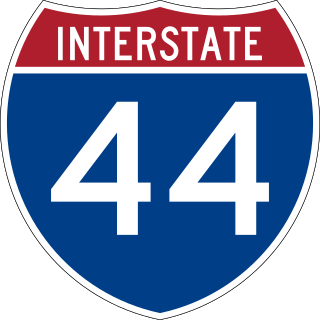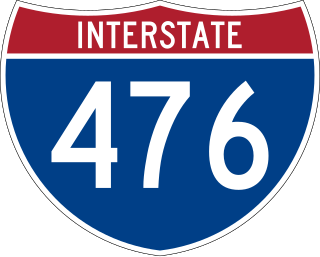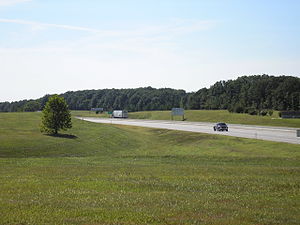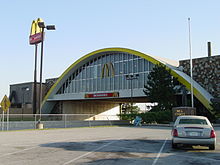
Interstate 44 (I-44) is an Interstate Highway in the central United States. Although it is nominally an east–west road as it is even-numbered, it follows a more southwest–northeast alignment. Its western terminus is in Wichita Falls, Texas, at a concurrency with U.S. Route 277 (US 277), US 281, and US 287; its eastern terminus is at I-70 in St. Louis, Missouri. I-44 is one of five Interstates built to bypass US 66; this highway covers the section between Oklahoma City and St. Louis. Virtually the entire length of I-44 east of Springfield, Missouri, was once US 66, which was upgraded from two to four lanes from 1949 to 1955. The section of I-44 west of Springfield was built farther south than US 66 in order to connect Missouri's section with the already completed Will Rogers Turnpike, which Oklahoma wished to carry their part of I-44.

The Kansas Turnpike is a 236-mile (380 km) controlled-access toll road that lies entirely within the US state of Kansas. It runs in a general southwest–northeast direction from the Oklahoma border to Kansas City. It passes through several major Kansas cities, including Wichita, Topeka, and Lawrence. The turnpike is owned and maintained by the Kansas Turnpike Authority (KTA), which is headquartered in Wichita.

The John Kilpatrick Turnpike is a controlled-access toll road in Oklahoma City, Oklahoma. The turnpike forms a partial beltway that runs from State Highway 152 (SH-152) to an interchange with Interstate 35 (I-35) and I-44. At the eastern terminus, traffic continuing east merges with I-44 traffic, forming the Turner Turnpike. The Kilpatrick Turnpike is 29.4 miles (47.3 km) long.

The Turner Turnpike is a controlled-access toll road in central Oklahoma, connecting its two largest cities, Oklahoma City and Tulsa. Authorized by the Oklahoma Legislature in 1947 and opened in May 1953, it is the oldest of the state's eleven turnpikes. The route is signed as Interstate 44 for its entire length, but was constructed prior to its designation as such. The Turner Turnpike was named after Governor Roy J. Turner, who pushed for efforts to build this toll road to connect the state's two largest cities.

The Cimarron Turnpike is a controlled-access toll road in north-central Oklahoma. The route travels 67 miles (108 km), from an interchange with Interstate 35 (I-35) north of Perry, to Westport, just west of Tulsa. The route also consists of a 7.2-mile (11.6 km) spur which runs from the mainline southwest to an interchange with U.S. Route 177 (US-177) north of Stillwater.

Interstate 476 (I-476) is a 132.1-mile (212.6 km) auxiliary Interstate Highway of I-76 in the U.S. state of Pennsylvania. The highway runs from I-95 near Chester north to I-81 near Scranton, serving as the primary north–south Interstate corridor through eastern Pennsylvania. It consists of both the 20-mile (32 km) Mid-County Expressway, locally referred to as the "Blue Route", through Delaware and Montgomery counties in the suburban Philadelphia area, and the tolled, 110.6-mile (178.0 km) Northeast Extension of the Pennsylvania Turnpike, which connects the Delaware Valley with the Lehigh Valley, the Pocono Mountains, and the Wyoming Valley to the north.

State Highway 66 is a 192.7-mile (310.1 km) state highway in the U.S. state of Oklahoma, beginning at U.S. Highway 81 in El Reno and ending at U.S. Highway 60 near White Oak. The highway was designated in 1985 as a replacement for the decommissioned U.S. Highway 66. Although most of the highway follows Historic Route 66, the highway follows US 66's final alignment, joining Interstate 44 through Tulsa and Oklahoma City, while older versions of the route follow various city streets through both cities.

The Indian Nation Turnpike, also designated State Highway 375 (SH-375), is a controlled-access toll road in southeastern Oklahoma, United States, running between Hugo and Henryetta, a distance of 105.2 miles (169.3 km). It is the longest tollway in the state.

The H. E. Bailey Turnpike is an 86.4-mile (139.0 km) controlled-access toll road in the southwestern region of the U.S. state of Oklahoma. The route, opened on April 23, 1964, is a four-lane freeway that connects Oklahoma City to Lawton in its northern section and Lawton to Wichita Falls along its southern section, roughly paralleling U.S. Route 277. The turnpike also includes an 8.2-mile (13.2 km) spur route that leads toward Norman, Oklahoma. Since 1982, it has been signed as a part of Interstate 44, and as such uses its mileposts. Travel along the full length of the toll road costs $5.50 for a two-axle vehicle.

The Chickasaw Turnpike, also designated State Highway 301 (SH-301), is a controlled-access toll road in the rural south central region of the U.S. state of Oklahoma. A two-lane freeway, it stretches for 13.3 miles (21.4 km) from north of Sulphur to just south of Ada. The Oklahoma Turnpike Authority (OTA) owns, maintains, and collects tolls on the turnpike. The first section of the Chickasaw Turnpike opened on September 1, 1991.

The historic U.S. Route 66, sometimes known as the Will Rogers Highway after Oklahoma native Will Rogers, ran from west to northeast across the state of Oklahoma, along the path now taken by Interstate 40 (I-40) and State Highway 66 (SH-66). It passed through Oklahoma City, Tulsa, and many smaller communities. West of the Oklahoma City area, it has been largely replaced by I-40; the few independent portions that are still state-maintained are now I-40 Business. However, from Oklahoma City northeast to Kansas, the bypassing I-44 is mostly a toll road, and SH-66 remains as a free alternate.

The Will Rogers Archway, originally named the Glass House Restaurant and still nicknamed "The Glass House", is a 29,135-square-foot (2,706.7 m2) service station that spans the Will Rogers Turnpike section of Interstate 44 (I-44) near Vinita, Oklahoma. Previously operating as a McDonald's restaurant, it was notable as the first bridge restaurant opened over a U.S. highway and as an example of a U.S. roadside restaurant. When it was solely a McDonald's, it was the world's largest McDonald's before the current largest McDonald's in the world located in Orlando, Florida was built.

Interstate 77 (I-77) in the US state of West Virginia is a major north–south Interstate Highway. It extends for 187.21 miles (301.29 km) between Bluefield at the Virginia state line and Williamstown at the Ohio state line.

The Creek Turnpike, also designated State Highway 364 (SH-364), is a 33.2-mile (53.4 km) controlled-access toll road that lies entirely in the U.S. state of Oklahoma. The turnpike forms a partial beltway around the south and east sides of Tulsa, Oklahoma's second largest city. The Creek Turnpike's western terminus is at the Turner Turnpike in Sapulpa, while its northeastern terminus is at the Will Rogers Turnpike in Fair Oaks; both ends of the Creek Turnpike connect with Interstate 44 (I-44). Along the way, the highway passes through the cities of Sapulpa, Jenks, Tulsa, and Broken Arrow, and the counties of Creek, Tulsa, Wagoner and Rogers. The road is maintained by the Oklahoma Turnpike Authority (OTA), except for a brief free section shared with U.S. Route 64 (US-64) and US-169. This free section is maintained by the Oklahoma Department of Transportation (ODOT).

U.S. Route 69 is a major north-south U.S. Highway in the U.S. state of Oklahoma. It extends the corridor formed by U.S. Route 75 in Texas, from Dallas northeast via McAlester and Muskogee to the Will Rogers Turnpike near Vinita. From Vinita to the Kansas state line, US-69 generally parallels the turnpike along old U.S. Highway 66.

Interstate 44 (I-44) runs diagonally through the US state of Oklahoma, spanning from the Texas state line near Wichita Falls, Texas, to the Missouri border near Joplin, Missouri. It connects three of Oklahoma's largest cities: Oklahoma City, Tulsa, and Lawton. Most of I-44 in Oklahoma is a toll road. In southwestern Oklahoma, I-44 is the H. E. Bailey Turnpike and follows a diagonally northwest–southeast direction. From Oklahoma City to Tulsa, I-44 follows the Turner Turnpike. As I-44 leaves Tulsa, it becomes the Will Rogers Turnpike to the Missouri border. In the Lawton, Oklahoma City, and Tulsa metro areas, I-44 is toll-free. In Oklahoma City, I-44 is also known as the Will Rogers Expressway.

Oklahoma has an extensive turnpike system, maintained by the state government through the Oklahoma Turnpike Authority. All of Oklahoma's turnpikes are controlled-access highways. The majority have at least four lanes, though the Chickasaw Turnpike is two lanes.

U.S. Route 169 is a U.S. highway that begins in Tulsa southeast of Downtown. The highway runs north into Kansas.

U.S. Route 412 is a U.S. highway in the south-central portion of the United States, connecting Springer, New Mexico to Columbia, Tennessee. A 504.11-mile (811.29 km) section of the highway crosses the state of Oklahoma, traversing the state from west to east. Entering the state southwest of Boise City, US-412 runs the length of the Oklahoma Panhandle and serves the northern portion of the state's main body, before leaving the state at West Siloam Springs. Along the way, the route serves many notable cities and towns, including Boise City, Guymon, Woodward, Enid, and the state's second-largest city, Tulsa.

U.S. Route 64 (US-64) is a U.S. highway running from the Four Corners area to the Outer Banks of North Carolina. Between these two points, the highway passes through the entire width of Oklahoma; a total of 591.17 miles (951.40 km) of US-64 lies in the state of Oklahoma. US-64 enters the state from New Mexico, crossing the line between the two states between Clayton, New Mexico, and Boise City in Cimarron County. The route runs the full length of the Oklahoma Panhandle, then serves the northernmost tier of counties in the main body of the state before dipping southeastward to Tulsa, the state's second-largest city. From Tulsa, the highway continues southeast, leaving Oklahoma just west of Fort Smith, Arkansas. In addition to Tulsa, US-64 serves fifteen Oklahoma counties and the cities of Guymon, Woodward, Enid, and Muskogee.























